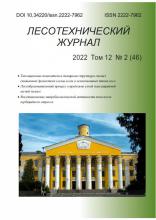Bratsk, Irkutsk region, Russian Federation
Man'chzhuriya, China
When implementing the technological process in the forest for logging operations, various factors influence, as well as taxation indicators such as (average diameter, height of the stand, reserve per hectare, availability of growth, completeness, etc.), natural climatic factors (Soil type carrying capacity of soils, depth of snow cover, etc.), degree of operator training, etc. One of the main tasks of rational justification of the technological process of cutting areas development is to find and combine controlled factors, at which performance indicators would be extreme. The most suitable variant of the technological development of the cutting area assumes what should be the intensity of logging, the layout of the cutting area, the number of loading points, and the productivity of harvesting machines. This task will be solved taking into account the influence of logging equipment and technology on the forest environment. The state of the stand left for growing after selective felling and its further development depends on the machine systems used in logging operations. The most important factor in the development of felling areas is the degree of intensity of felling. Since the quality of logging operations will depend on the method of cutting in the development of the cutting area (from the point of view of the impact on the natural environment, the soil cover, the left part of the stand, the adolescent).
low-disturbed forest areas, technological and environmental factors, timber exploitation, harvesting technology, environmental requirements.
Введение. При осуществлении технологического процесса в лесу на выполнение лесозаготовительных операций влияют различные факторы, а также таксационные показатели, такие как средний диаметр, высота древостоя, запас на 1 га, наличие подроста, полнота древостоя; природно-климатические факторы – тип почв, несущая способность грунтов, глубина снежного покрова, степень подготовки оператора [1, 2, 4]. В данных условиях исследуемая система сложна, и ее изучение путем прямого экспериментирования или аналитического решения затруднено, но в данном случае можно проследить поведение отдельных элементов системы. Исходя из вышеизложенного, наиболее подходит метод имитационного моделирования. Имитационное моделирование включает:
– описание поведения системы;
– построение теорий и гипотез, которые могут объяснить наблюдаемое поведение;
– использование этих теорий для предсказания будущего поведения системы.
1. Grebenyuk, A. L., the Allocation of forests of high environmental value in industrial forests of the middle Angara region. / Natural science and engineering complex of the Irkutsk region: proceedings of Megrahi-tional scientific and technical conference. - Bratsk: GOU VPO "the Brest state University", 2008. - 241 p.
2. Grebenyuk, A. L., Runova E. M. Silvicultural and environmental aspects to identify forests of high environmental value in the exploitable forests of Irkutsk region. / Bulletin Of The Council. - 2009. -№ 2 (28) p. 37-42
3. Vedernikov I. B., Runova E. M., Grebenyuk A. L. Rationale for selection of environmental co-Sidorov in the forests of Irkutsk region. / Bulletin Of The Council. - 2009. - № 11 (38) p. 83-87.
4. Grebenyuk A. L. Ecological mapping of biological resources. // Proceedings of the Bratsk state University: Univ. Natural and engineers-engineering science - the development of the Siberian regions. in 2 V. - Khabarovsk: Publishing house of the Brest state University, 2011. - T. 1. - 125 p.
5. Grebenyuk, A. L., Runova E. M. Reproduction of Le-owls on the basis of criteria of sustainable forest management. / Actual problems of forestry / edited by E. A. Pamfilova. Proceedings of the international scientific-technical conference. Issue 15. - Bryansk: BGITA, 2006. - 134 p EDN: https://elibrary.ru/TZQEPF
6. Grebenyuk, A. L., A. N Dry. Methods of identifying elements of biodiversity and key habitats in the exploitable forests of the Irkutsk Area. / Prospects of development of the forest complex Irkut-tion region: materials of the international scientifically-practical conference. - Bratsk: GOU VPO "the Brest state University", 2007. - 140 p.
7. Jang, S. A., Puzanova O. A., Grebenyuk A. L. Sonero-tion of forest ecosystems exposed to industrial emissions. / Systems. Methods. Technologies. - 2014. - №1(21) - p. 153-157. EDN: https://elibrary.ru/RZKKOX
8. Grebenyuk, A. L., the allocation Settings environmental-ski significant commercial forest. Natural and engineering Sciences - development of regions of Siberia: materials of XII (XXXIV) all-Russian scientific-technical conference. - Khabarovsk: Publishing house of the Brest state University, 2013. - 191 p. EDN: https://elibrary.ru/SZAZTR
9. Grebenyuk, A. L., I. A. Garus the Problem of accessibility of forest resources. / Actual problems of forest com-Plex/ ed. by E. A. Pamfilova. Proceedings of the international scientific-technical conference. Edition 39. - Bryansk: BGITA, 2014. - 147 p.
10. Grebenyuk A. L. The development of ecological and lesovodstve-tion of commercial forest activities on the basis of the priority target regional complexes. / AK-toiling problems of forestry/ Under the General editorship of E. A. Pamfilova. Proceedings of the international scientific-technical conference. Issue 31. - Bryansk: BGITA, 2012. - 215 p.
11. Grebenyuk, A. L. the Use of GIS technologies in the analysis of the forest Fund. // Proceedings of the Bratsk state University: Univ. Natural and engineer-ing science: 2T. - Bratsk: Publishing house of the Brest state University, 2014. - vol. 1 - pp. 357-361.
12. Grebenyuk A. L. Socio-economic problems of implementation of voluntary forest certification in Eastern Siberia. / Actual problems of forestry / edited by E. A. Pamfilova. Collection-nick of scientific papers on the results of international scientific-technical conference. Issue 10. - Bryansk: BGI-TA, 2005. - p. 171-173
13. Miller D.H. The factor of scale: ecosystem, landscape mosaic, and region. // In: K.A.Hammond, G.Macinko B.Fairchild (eds.) “Sourcebook on the Environment: A Guide to the literature”. Chicago, IL: University of Chicago Press, 1978. - Pp. 63-88.
16. Jaeger J.A.G. Landscape division, splitting index, and effective mesh size: new measures of landscape fragmentation. // Landscape Ecology, vol. 15, (2000). - Pp. 115-130. EDN: https://elibrary.ru/AGQFEN












